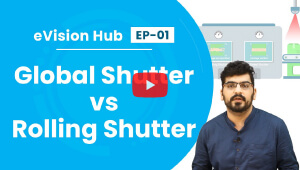CMOS Rolling Shutter Cameras
What are rolling shutter cameras?
Rolling shutter cameras are equipped with very simple and robust architecture for sensor exposure and read-out. It makes image sensor chips easy and compact compared to global shutters, which have a memory element for each pixel. Hence, this triggers more complexity in building the architecture. However, the compactness of rolling shutters ensures that more pixels can be fitted in relatively smaller image sizes. Their pixels can be as small as 1μm or lesser - leading to huge bumps in megapixels. Even today, the rolling shutter architecture continues to evolve - incorporating innovations like readout-based multi-exposure HDR, LFM technology, and more.
So, unlike popular belief, a rolling shutter camera can perform many functions such as multi-camera synchronization which involves aligning the shutter to external interrupts or sensors, triggering the sensor exposure and read-out, etc.
Other benefits of rolling shutter cameras:
- Increased shutter speed and high frame rates
- Low cost of sensors
- Excellent sensitivity for imaging
- The lack of a memory element eliminates ghosting issues that impact shutter efficiency in low-light conditions
How does a rolling shutter sensor work?
The rolling shutter mode in a camera exposes the pixel rows one after the other with a temporal offset. First, the top row of the image collects and processes the light - followed by the next row, and so on. Therefore, it causes a delay in the overall light collection process for consecutive rows. However, the total light collection time for each row is exactly the same.For further reading on choosing the ideal CMOS sensor size, please check out the below blog post:
In addition, to learn why CMOS became the most used technology in embedded vision, please give the below blog post a read:
Why is the Global Reset Release (GRR) mode so crucial?
First, it's important to understand that sensors in rolling shutter cameras get exposed at different times. As a result, it creates distortion while capturing fast-moving objects (where the speed of the object is greater than the camera's shutter speed)
Hence, the Global Reset Release (GRR) mode makes rolling shutter cameras come closer to achieving global shutter-like performance. It does so externally by using a strobe LED flash or a mechanical shutter to match the performance of global shutter cameras while capturing fast-moving subjects. So, in the GRR mode, the reset of all the rows occurs simultaneously - ensuring all the rows are exposed to the scene at the same time.
To learn more about the concept of global reset release, please check out the article What is Global Reset Release? How does it work in e-con cameras?
Camera Products
Resources
Company
Help
Social
Copyright © e-con Systems® | Site Map
Language Preferences
Default is {currentLanguage}. Would you like to switch language?
You may not be able to access content or other services correctly without cookies. Know more



 Mr. Thomas Yoon
Mr. Thomas Yoon +82-10-5380-0313
+82-10-5380-0313







